Nikon Coolpix S1100pj Review
Nikon Coolpix S1100pj Introduction
The Nikon Coolpix S1100pj is the second digital camera with a built-in projector. The 14 lumen projector can display images up to 47" diagonally 2.4 meters away at VGA resolution. This is packed in an ultra-compact body along a 14 megapixels sensor, 5X wide-angle optical zoom lens and 3" high-resolution touch-screen.
Like most ultra-compact cameras, the Nikon S1100pj is strictly a point-and-shoot model with control over EC, ISO and white-balance. At least a custom white-balance function is included for difficult lighting. This model can also record 720p video which can be played back in Standard Definition (SD) through the built-in projector.
Key Features
- 14 Megapixels sensor
- ISO 80 to 1600 at full resolution
- ISO 3200 & 6400 at 3 megapixels
- Shutter-speed range from 1/1500s to 4s
- 5X stabilized optical zoom, equivalent to 28-140mm, F3.5/5.8-8
- -2..+2 Exposure-Compensation, in 1/3 EV stops
- Automatic, Custom and 5 Preset White-Balance
- Single-shot, Continuous, BSS and Multishot Drive modes
- Auto, Redeye, Off, On and Slow-Sync Flash modes
- 2s and 10s Self-Timers
- 14 Lumen VGA-resolution projector
- Projected size from 5" to 47"
- Projection distance from 26cm to 2.4m
- Image and video projection with slide-show features
- PC projection via USB port
- 1280x720 @ 30 FPS HD Video capture
- 3" LCD touch-screen with 460K Pixels
- Infrared Remote Control included
- Secure Digital Extended Capacity (SDXC)
- Lithium-Ion Battery
Nikon Coolpix S1100pj Capability - What can it do?
As the Nikon Coolpix S1100pj and its predecessor are the only two digital cameras to feature a projector, the core capabilities of these modes are the projector. The projector either works as an external display for the camera's Playback mode or as an external display for a PC or Mac. In both cases, the resolution is equivalent to a VGA display, higher than the camera's own LCD but lower than most projectors.
In Playback mode, the projector shows exactly the same display as the LCD, showing images and videos, individually or as part of a slide-show. The slide-show can be controlled via the touch-screen display or the included infrared remote control. It features a choice of transitions and an optional fixed sound-track. The remote can start and stop the slide-show as well as move between frames.
 At 14 lumens for such a small battery-powered projector, performance is impressive. The projected image is bright enough to be seen in moderate lighting but the ambient should be dim to fully appreciate the output. The image is focused manually, which seems odd considering this is a camera with autofocus and an assist lamp. At the maximum distance of 2.4 meters, image size is 47" diagonally. As a projector, battery life is quoted to be 1 hour. This lets you quickly share images here and there but is too short for presentations, particularly since the S100pj does not accept power from the USB connection which would have avoided this problem.
At 14 lumens for such a small battery-powered projector, performance is impressive. The projected image is bright enough to be seen in moderate lighting but the ambient should be dim to fully appreciate the output. The image is focused manually, which seems odd considering this is a camera with autofocus and an assist lamp. At the maximum distance of 2.4 meters, image size is 47" diagonally. As a projector, battery life is quoted to be 1 hour. This lets you quickly share images here and there but is too short for presentations, particularly since the S100pj does not accept power from the USB connection which would have avoided this problem.
The Nikon S1100pj also takes pictures and video. It's 14 megapixels sensor means that rather large prints are theoretically possible but a tiny sensor like this one tends to reduce this. Videos are recorded at 720p which is now the norm among most cameras. The full-resolution ISO range goes from 80 to 1600 which gives some versatility but exposure is otherwise quite limited. The top shutter-speed of 1/1500s can freeze most non-motorized sports as long as there is enough light entering the lens. The slowest shutter-speed of 4 seconds is not long enough for night photography. One can increase ISO but that makes things really noisy, destroying shadow details that are quite important at night. The only user-control over exposure is the requisite plus or minus two stops of exposure-compensation.
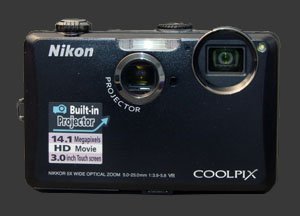
The non-protruding folded-optics lens has a 5X optical zoom range, equivalent to 28-140mm in 35mm-equivalent terms. This represents a wide-angle to short telephoto range that is well-suited for indoor shots, portraits, close-ups and general photography. The maximum aperture is on the the dim side at both ends of the zoom, F/3.9 at 28mm and F/5.8 at 140mm. This will obviously force the camera to select slow shutter-speeds or increase ISO sensitivity when possible which has detrimental effects.
Color is controlled by white-balance alone. There is an AWB mode, 5 presets and a custom white-balance function. This last option lets users precisely set the color-temperature to deal with difficult lighting conditions. There are two self-timers and five standard flash modes to choose from. Double-tapping the LCD gives access to one of three functions:
- Touch Shutter which simply takes a picture using the tapped focus-point.
- Subject Tracking which starts Tracking AF-C with the tapped subject.
- AE-L/AF-L which locks focus and exposure using the tapped point.
Nikon Coolpix S1100pj Usability - How easy is it to use?
The S1100pj has a nearly rectangular body with only a few protrusions at the top. This makes it difficult to hold securely, which is generally the case for ultra-compact cameras. To help secure the camera, there is a small catch for the thumb on the rear and a simple wrist-strap. It does have a good weight to it and feels solid. The built-in sliding lens cover seems to protect the lens well.
A standard two-stage shutter-release is found at the top of the camera. It is wrapped by the zoom controller and has a distinct halfway point with the full-press being just a hair further. The camera starts focusing as soon as the shutter is pressed but it generally needs a short wait on the half-press to lock. The zoom controller is responsive and moves the lens quickly across its range. There are only 8 steps in the 5X range which is too coarse for precise framing without repositioning the camera.
 On the top of the camera, to the left of the shutter-release is a small power-switch which is flush with the surface. It prevents accidentally turning the camera on but also turning it on at all when using gloves. Further to the left is the projector control. The button in its center turns the projector on and off, entering Playback mode as needed. Around it is the manual focus dial for the projection. Since the image forms at a plane of focus, as with all projectors, the camera must be positioned before focusing the projector. The bump to the left of the projector control is the top of the lens opening.
On the top of the camera, to the left of the shutter-release is a small power-switch which is flush with the surface. It prevents accidentally turning the camera on but also turning it on at all when using gloves. Further to the left is the projector control. The button in its center turns the projector on and off, entering Playback mode as needed. Around it is the manual focus dial for the projection. Since the image forms at a plane of focus, as with all projectors, the camera must be positioned before focusing the projector. The bump to the left of the projector control is the top of the lens opening.
The left side of the camera is completely bare while the right side has a small loop to attach the wrist-strap and a soft rubber cover protecting the combined USB & A/V connector. The loop can be bothersome after prolonged use, depending on how tightly you like holding the camera. Being a multi-purpose connector, this one does not accept standard mini-USB cables. It does not accept power over USB either which limits projector use to short presentations only.
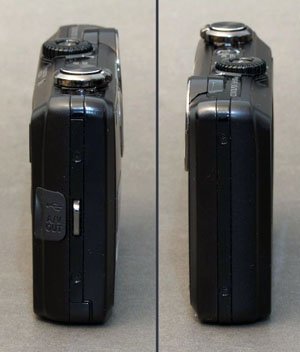
The rear of the Nikon Coolpix S1100pj is quite empty. The 460K pixels high-resolution 3" LCD takes most of the space there. The display is sharp and bright with an excellent viewing-angle. Visibility is also quite good except in very bright light. Motion is fluid and the display keeps up nicely under most conditions.
Only three buttons are found to the right of the LCD. The top of these controls is the video-recording button. This button starts recording video after a 2 second delay and stops it after 1 second. There is no video mode on this camera. Since HD videos have a different aspect ratio than images, it is impossible to setup framing before filming. The initial recording delay makes matters considerable worst, as the display goes blank while the camera prepares itself for filming. This honestly makes the video feature border on useless but this is not the only modern camera to do so.
The second button on the rear is the Camera Mode button. This one returns to Capture mode from Playback mode and displays the Mode selection screen. There are 4 modes to choose from, Easy Auto, Auto, Scene and Smart Portrait. No matter which mode is chosen, the camera is automatic. In Easy Auto mode, the camera chooses a scene mode while in Scene mode the user chooses it. Easy Auto mode cannot guess any scene mode though, so Scene is required to access the Panorama Assist mode for example. Smart Portrait is just another scene mode that combines a few functions such as Face-Detection and Skin-Smoothing.
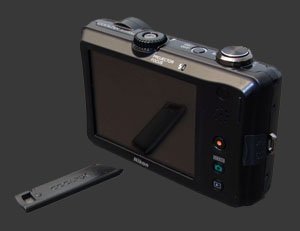 The last button is the Playback button which enters Playback mode but does not exit it. Instead, pressing the Playback button while in Playback mode displays the Playback menu. The camera will exit Playback mode if the shutter-release is pressed. The S1100pj is not entirely shooting-priority though as a tap of the shutter does not turn the projector off.
The last button is the Playback button which enters Playback mode but does not exit it. Instead, pressing the Playback button while in Playback mode displays the Playback menu. The camera will exit Playback mode if the shutter-release is pressed. The S1100pj is not entirely shooting-priority though as a tap of the shutter does not turn the projector off.
Notice the lack of a 4-way controller. This digital camera replaces it by a touch-screen display. While the mode and playback menus can be invoked using hard buttons, using those menus requires interaction with the touch-screen. This is one of those terrible ideas we hope can disappear forever as this forces a slow interaction model. When used with your fingers, this is not only imprecise but it also dirties the screen quite quickly, reducing visibility at the same time. An included stylus avoids both these problems but we challenge anyone to use it comfortably while taking pictures and not risk losing it afterwards. Just imagine holding a gripless camera with your right hand to frame and prepare to shoot while using your left hand to adjust EC with the stylus. At least this made it possible to use the S1100pj with gloves on from a tripod.
The bottom of the camera has a very flimsy compartment door, a projector stand and a plastic tripod mount. The projector stand just angles the camera upwards at a small fixed angle. It is probably better than nothing but using this camera on a tripod is much better. The tripod mount is neither aligned with the lens nor the camera's center.
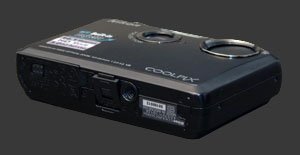
Other than the shutter-release and zoom-controller, usability is simply a pain with this Coolpix. Exposure-Compensation particularly is slow to use since one must use the touch-screen to invoke the shooting menu, jump to the EC display and select the amount using a small scale. Doing it with your finders lets you hold the camera better but, when it is time to set the EC value, the steps are too close together to select just one. This can be done using the stylus left-handed but it is not particularly comfortable.
Setting white-balance, flash mode, macro-focus, drive-mode or the self-timer is similar except instead of a scale you get a palette of icons to choose from. Only the title of the currently selected icon is shown, so it is important to memorize the significance of each of them. Otherwise, you have to use trial-and-error which keeps you using the touch-screen even longer. The Setup menu is organized as a palette of options with a 3-page scrollbar which is difficult to aim at without accidentally triggering a submenu.
Nikon Coolpix S1100pj Performance - How well does it take pictures?
This ultra-compact produces 14 megapixels images at ISO 80 to 1600 and 3 megapixels ones at ISO 3200 and 6400. With such a small sensor size, it may not surprise anyone that noise is noticeable starting at the base ISO. This eats away fine details which reduces possible print sizes compared to what one expects from a 14 megapixels image. Still, most common print sizes are quite possible and 9x12" prints look smooth. ISO 100 is not much different but gets a tad softer, most likely due to noise-reduction.
At ISO 200 things get even softer and more details get destroyed but noise is not much more noticeable. This is certainly a case of aggressive noise-reduction. ISO 400 looks drastically different. Strangely the increase in noise at that level makes images look sharper. There are no more details there but noise is clearly visible, reducing print sizes further. ISO 800 is both noisier and softer but can be used for small prints. Anything above ISO 800 is completely void of details.
Color accuracy is generally good with a gentle amount of over-saturation compared to reality. White-balance is generally quite good, but far from perfect. In very cloudy conditions, the S1100pj leaves too much blue, something which is particularly noticeable on snow. Luckily, this camera is equipped with a custom white-balance setting which lets it achieve exact results when needed. There are no metering options at all on this camera, so it is relief to find that metering is generally reliable and predictable. As most cameras, it tends to under-expose bright scenes and over-expose dark ones but rarely by more than 2/3 EVs.
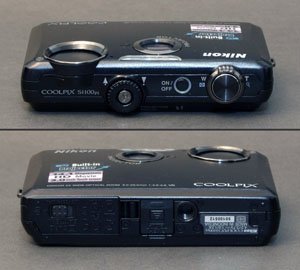
Nikon managed to create a distortion-free folded-optics lens for this Coolpix. No noticeable barrel or pincushion distortion can be seen at any focal-length. This is very impressive for this type of lens. On the other hand, the 5X optical-zoom lens shows pronounced vignetting at all corners from wide-angle to about 1/3 of the way through the zoom range. It does disappear towards the telephoto end. This lens manages to focus accurately down to low light-levels.
In terms of performance, the Nikon Coolpix S1100pj is generally good. It takes 1½s to power-on and 1s to power off. The lens moves quite rapidly from one end to the other of its range. Focusing takes on average 1 second, with little divergence from that. Even in bright light, it does not get much faster and in low-light it never takes much more either. The shutter-lag is short enough to catch motion at a precise point as long as the camera has been prefocused properly. Shot-to-shot speed is almost 3 seconds which is just a little on the slow side for an ultra-compact.
Most other operations are clearly on the slow side. It takes almost 2 seconds to enter and exit Playback mode. Touching the LCD to activate an option causes it to start responding immediately most of the time but. since this is always accompanied by an animation, it takes at least one second to select any top-level option. It does happen that the screen does not recognize being touched and so 2 or 3 trials to activate something are not unexpected. The biggest aggravation is the time it takes to set EC which is between 2 and 3 seconds.
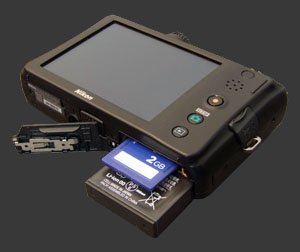 Playback mode itself is quite slow, with noticeable delays to zoom, scroll and change images. It takes 3 seconds for the projector to come to life and less than 1 second for it to shutdown. Battery life is quoted as 220 shots-per-charge in capture mode and 1 hour in projector mode. We have no battery-life reference for the projector but 220 shots is below average among ultra-compact digital cameras.
Playback mode itself is quite slow, with noticeable delays to zoom, scroll and change images. It takes 3 seconds for the projector to come to life and less than 1 second for it to shutdown. Battery life is quoted as 220 shots-per-charge in capture mode and 1 hour in projector mode. We have no battery-life reference for the projector but 220 shots is below average among ultra-compact digital cameras.
There is no video mode on this camera and so the camera is unprepared when the video-recording button is pressed. It takes almost 3 seconds for it to start recording video which is enough to miss the beginning of whatever you are trying to record. It takes 1 second for it to stop recording as well. During video recording, the S1100pj can operate its zoom. It does so very slowly and quietly to avoid adding noise to the audio track.
Nikon Coolpix S1100pj Conclusion
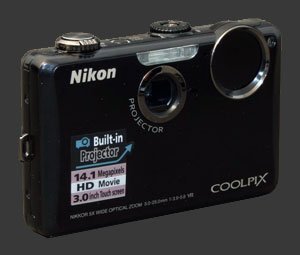 The Nikon Coolpix S1100pj is all about its projector. Given the fact that this camera is as ultra-compact as many of its peers without a projector, this is an achievement in itself. The projector works well and can project an image up to 47" diagonally from 2.4 meters away. The output is clear with a resolution similar to a standard definition television. With only an hour of battery-life, making use of the projector may need more than one set of batteries but can provide an instant large-view sharing experience.
The Nikon Coolpix S1100pj is all about its projector. Given the fact that this camera is as ultra-compact as many of its peers without a projector, this is an achievement in itself. The projector works well and can project an image up to 47" diagonally from 2.4 meters away. The output is clear with a resolution similar to a standard definition television. With only an hour of battery-life, making use of the projector may need more than one set of batteries but can provide an instant large-view sharing experience.
The remainder of the S1100pj is as simple as it gets. In Auto mode, it takes reasonable pictures with good color, white-balance and no distortion. While noise is visible at all ISOs, 14 megapixels images from this Coolpix look smooth up to ISO 800 for most common print sizes. These is not much to do beyond the most basic controls but, when it is necessary, the S1100pj's user interface really gets in the way. It is simply too inefficient to get things done without being frustrated. Video is certainly the biggest victim of that interface.
In the end, there is not much to say about this camera. Those who want a projector have nowhere else to look and those who do not can easily find something better for less.
 |
Please Support Neocamera
All information on Neocamera is provided free of charge yet running this website is a huge endeavor. Purchases made via affiliate links found throughout the site help keep it running and up-to-date. There is no additional cost to you, so please consider buying via these links to our affilates:
If you found any information on this site valuable and did not purchase via our affiliate links, please considering donating via PayPal:
Any amount will be greatly appreaciated. Thank you for your support!
Nikon S1100pj Highlights
Updates
2025.01.18

Fujifilm GFX 2025 Lens Roundup
Lens Review roundup of Fujifilm GFX Medium-Format lenses. Quality, performance and handling of the GF20-35mm F/4R WR, GF30mm F/3.5 Tilt-Shift and the GF55mm F/1.7.
2024.11.18

Best 2024 Photography Gifts for Every Budget
Great gifts for photographers and photo enthusiasts selected for every budget among the best products of 2024.
2024.08.07

Eye Protection Tips for Professional Photographers
The four main considerations for professional photographers regarding eyewear.
2024.07.14

Fujifilm X100VI Review
Flagship fixed-lens compact digital camera with a 40 MP sensor and Image-Stabilization, a first for the series. Retro design featuring dual control-dials, plus direct ISO, Shutter-Speed and EC dials. Its hybrid viewfinder can switch between EVF and OVF mode.
2024.05.09

Fujifilm GFX100 II Review
Flagship 102 Megapixels Medium-Format Mirrorless Digital Camera with 8-Stop 5-Axis IBIS, 8 FPS Drive, 8K Video and 400 MP Super-Resolution capture in a weatherproof and freezeproof body with dual control-dials and dual memory-card slots.
2024.04.03

Fujifilm X-T5 Review
Newest Fujifilm flagship boasting a 40 MP APS-C sensor, 5-axis IBIS with 7-stop efficiency, 15 FPS continuous drive, 6.2K Video capture, dual control-dials and dual SDXC UHS-II slots in a sturdy weatherproof and freezeproof body.
2023.11.20

Best Digital Cameras of 2023
Find out which are the Best Digital Cameras of 2023. All the new Mirrorless Digital Cameras from entry-level to high-end professional.
2023.07.10

Fujifilm X-H2 Review
40 Megapixels APS-C Hybrid Mirrorless Digital Camera with 7-stop IBIS. Fastest shutter ever and 8K video capture. Large builtin EVF with 0.8X magnification and 5.8 MP, plus an Eye-Start Sensor. Packed with features and large number of controls in a weatherproof and freezeproof body.
2023.05.07

Sony FE 20-70mm F/4G Review
Review of the unique Sony FE 20-70mm F/4G lens. The optical zoom of this lens spans ultra-wide-angle and medium focal-length coverage, making it one of the most versatile Full-Frame lenses on the market.
2023.01.15

Huion Inspiroy Dial 2 Review
Review of the Huion Inspiroy Dial 2 tablet, a medium sized drawing surface with dual dials and customizable buttons. Connects via USB-C or Bluetooth 5.0 with Windows, Linux and Android support.
2022.12.08

How to Pack for a Photo Trip
Find out how to pack for a travel photography trip, carry your gear safely while meeting airline regulations.
2022.11.13

Best Digital Cameras of 2022
The best digital cameras of 2022. A short list of the most outstanding models in their respective categories. Choose one for yourself or as a gift.















